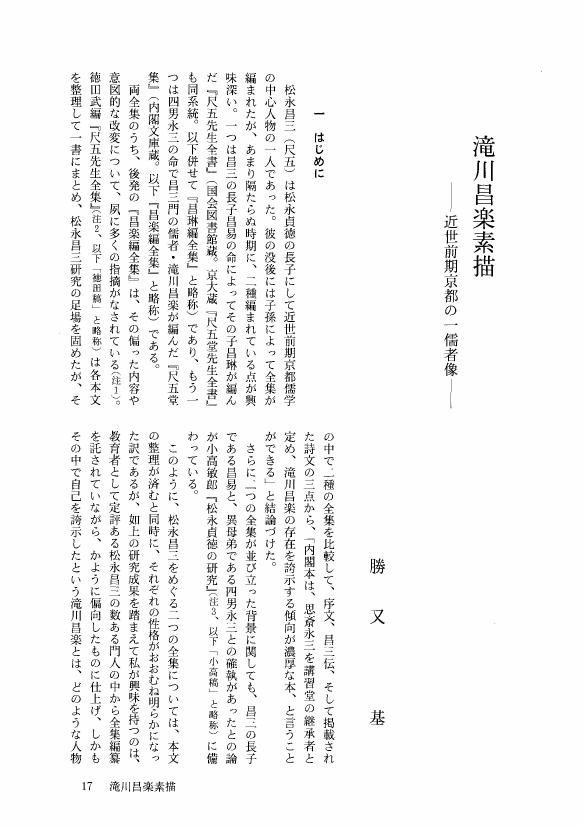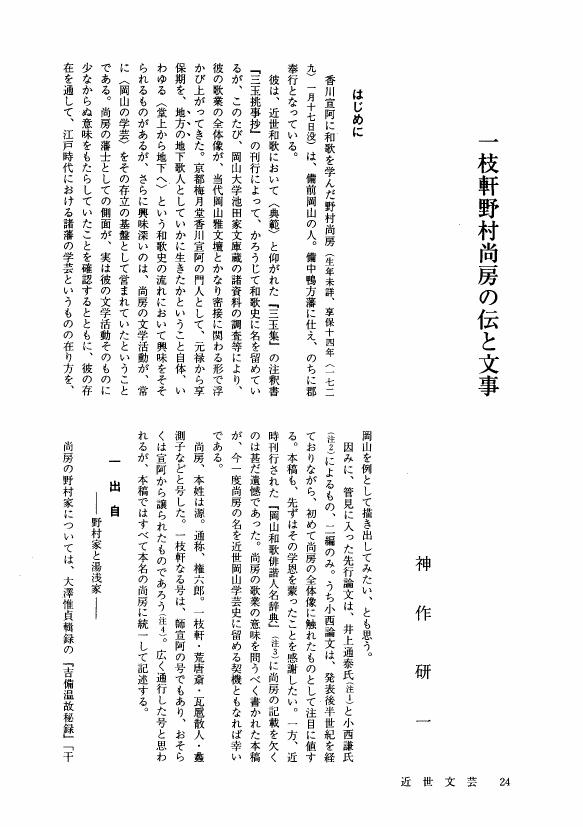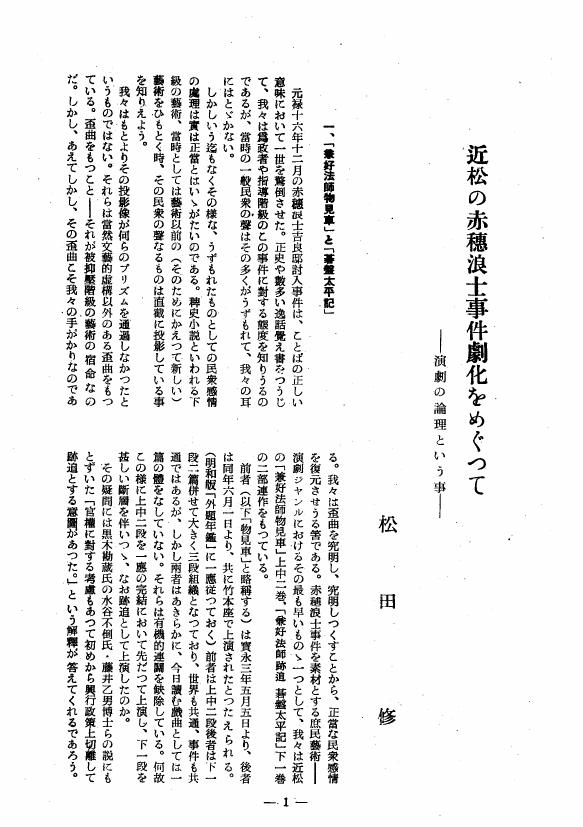1 0 0 0 OA 元禄の添削
- 著者
- 神作 研一
- 出版者
- 日本近世文学会
- 雑誌
- 近世文藝 (ISSN:03873412)
- 巻号頁・発行日
- vol.81, pp.17-32, 2005 (Released:2017-04-28)
1 0 0 0 OA 『黄葉夕陽村舎詩』前編巻一の編纂事情
- 著者
- 小財 陽平
- 出版者
- 日本近世文学会
- 雑誌
- 近世文藝 (ISSN:03873412)
- 巻号頁・発行日
- vol.87, pp.77-90, 2008 (Released:2017-04-28)
1 0 0 0 OA 岸本調和の撰集活動
- 著者
- 檀上 正孝
- 出版者
- 日本近世文学会
- 雑誌
- 近世文藝 (ISSN:03873412)
- 巻号頁・発行日
- vol.15, pp.1-10, 1968 (Released:2017-04-28)
1 0 0 0 OA 馬琴と小津桂窓の交流
- 著者
- 菱岡 憲司
- 出版者
- 日本近世文学会
- 雑誌
- 近世文藝 (ISSN:03873412)
- 巻号頁・発行日
- vol.90, pp.16-29, 2009 (Released:2017-04-28)
- 著者
- 染谷 智幸
- 出版者
- 日本近世文学会
- 雑誌
- 近世文藝 (ISSN:03873412)
- 巻号頁・発行日
- vol.106, pp.69-74, 2017
1 0 0 0 OA 宗因における出家とその意味
- 著者
- 尾崎 千佳
- 出版者
- 日本近世文学会
- 雑誌
- 近世文藝 (ISSN:03873412)
- 巻号頁・発行日
- vol.108, pp.17-36, 2018 (Released:2019-01-31)
It is often said that Nishiyama-Sōin, the master of renga linked verse, had started rendering haiku poems as a hobby since he became a Buddhist priest. This article will point out the falsehood of this view to review what it was to make renga and haiku poems in his literary and religious career. He actually started haiku not as a hobby but for a more practical purpose; he became so much engaged in social intercourse after entering the priesthood that he exploited haiku to facilitate his public life. This is why he used a different poetical pseudonym according to whom he entertained. Taking advantage of the rise of Ōbaku, the third sect of Zen Buddhism, Sōin gained a good reputation as a haiku poet with his songs of the culture of western Japan. Meanwhile he also continued to play a leading role in the renga circle of Ise Shrine. In short, he shrewdly adopted a double persona as a renga master and as a haiku poet to attain secular popularity.
1 0 0 0 OA 末期の中本型読本
- 著者
- 髙木 元
- 出版者
- 日本近世文学会
- 雑誌
- 近世文藝 (ISSN:03873412)
- 巻号頁・発行日
- vol.45, pp.49-69, 1986 (Released:2017-04-28)
1 0 0 0 OA 富尾似船年譜稿
- 著者
- 雲英 末雄
- 出版者
- 日本近世文学会
- 雑誌
- 近世文藝 (ISSN:03873412)
- 巻号頁・発行日
- vol.16, pp.40-53, 1969 (Released:2017-04-28)
1 0 0 0 OA 滝川昌楽素描
- 著者
- 勝又 基
- 出版者
- 日本近世文学会
- 雑誌
- 近世文藝 (ISSN:03873412)
- 巻号頁・発行日
- vol.75, pp.17-30, 2002 (Released:2017-04-28)
1 0 0 0 OA 平井紀宗
- 著者
- 水田 紀久
- 出版者
- 日本近世文学会
- 雑誌
- 近世文藝 (ISSN:03873412)
- 巻号頁・発行日
- vol.58, pp.46-54, 1993 (Released:2017-04-28)
1 0 0 0 西村遠里随筆考
- 著者
- 吉田 宰
- 出版者
- 日本近世文学会
- 雑誌
- 近世文藝 (ISSN:03873412)
- 巻号頁・発行日
- vol.105, pp.17-30, 2017
Nishimura-Enri (1718-1787) is an amateur astronomer in Kyoto who wrote <i>Kyokōshi</i> (1775), <i>Uchū-mondō</i> (1778), and many other essays. Tatsuo Hino, one of few critics who deal with his essays, importantly notes that the author often cites Kumazawa-Banzan's Confucian discourses. Indeed, although he learned much about astronomy from his predecessor Nishikawa-Joken, his philosophical aspect was to no small degree cultivated under the influence of Bazan. Critically following Hino's argument, here I will examine Nishimura's philosophical astronomy in order to shed a new light on the humanities and sciences of the mid-Edo Period.
1 0 0 0 OA 賀茂真淵の題詠観
- 著者
- 高野 奈未
- 出版者
- 日本近世文学会
- 雑誌
- 近世文藝 (ISSN:03873412)
- 巻号頁・発行日
- vol.87, pp.15-28, 2008 (Released:2017-04-28)
1 0 0 0 OA 一枝軒野村尚房の伝と文事
- 著者
- 神作 研一
- 出版者
- 日本近世文学会
- 雑誌
- 近世文藝 (ISSN:03873412)
- 巻号頁・発行日
- vol.63, pp.24-38, 1996 (Released:2017-04-28)
1 0 0 0 OA 近松の赤穂浪士事件劇化をめぐって
- 著者
- 松田 修
- 出版者
- 日本近世文学会
- 雑誌
- 近世文藝 (ISSN:03873412)
- 巻号頁・発行日
- vol.3, pp.1-14, 1956 (Released:2017-04-28)
1 0 0 0 OA 小西伯煕
- 著者
- 水田 紀久
- 出版者
- 日本近世文学会
- 雑誌
- 近世文藝 (ISSN:03873412)
- 巻号頁・発行日
- vol.54, pp.23-30, 1991 (Released:2017-04-28)
1 0 0 0 OA 馬琴と牧之の交流
- 著者
- 高橋 実
- 出版者
- 日本近世文学会
- 雑誌
- 近世文藝 (ISSN:03873412)
- 巻号頁・発行日
- vol.14, pp.48-56, 1968 (Released:2017-04-28)
1 0 0 0 OA 水戸藩儒酒泉竹軒と韻書『洪武聚分韻』の編纂
- 著者
- 倉員 正江
- 出版者
- 日本近世文学会
- 雑誌
- 近世文藝 (ISSN:03873412)
- 巻号頁・発行日
- vol.66, pp.31-40, 1997 (Released:2017-04-28)
1 0 0 0 OA 戸田旭山小伝
- 著者
- 福田 安典
- 出版者
- 日本近世文学会
- 雑誌
- 近世文藝 (ISSN:03873412)
- 巻号頁・発行日
- vol.70, pp.37-46, 1999 (Released:2017-04-28)
1 0 0 0 OA 岩田彦助の人と思想
- 著者
- 川平 敏文
- 出版者
- 日本近世文学会
- 雑誌
- 近世文藝 (ISSN:03873412)
- 巻号頁・発行日
- vol.98, pp.15-29, 2013 (Released:2017-04-28)
1 0 0 0 OA 荒木田麗女と本居宣長
- 著者
- 雲岡 梓
- 出版者
- 日本近世文学会
- 雑誌
- 近世文藝 (ISSN:03873412)
- 巻号頁・発行日
- vol.99, pp.89-103, 2014 (Released:2017-04-28)
















